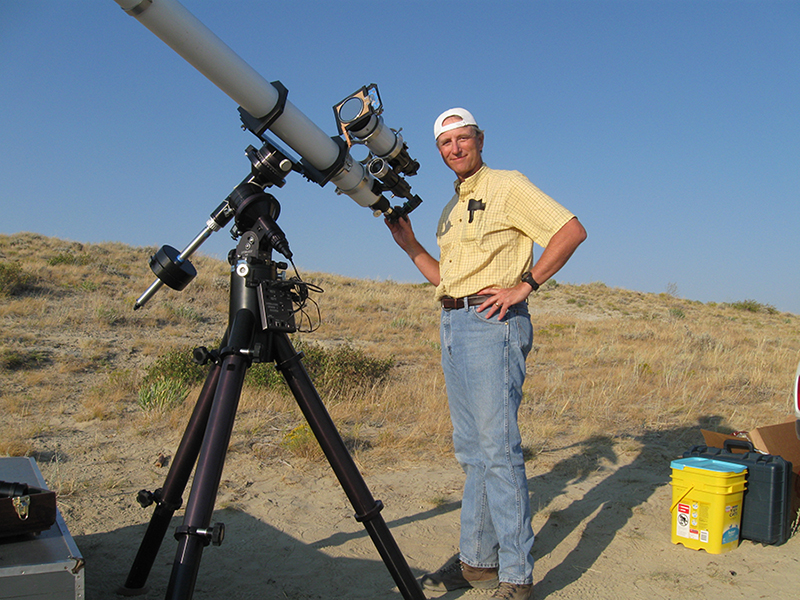News
SU Professor Mark Bottorff Traveled to Wyoming to Experience “Sublime, Metaphysical” Total Solar Eclipse
October 05, 2017
October 05, 2017
Open gallery

The recent total solar eclipse generated plenty of excitement across the entire country, but for an astronomer whose first job was working at a telescope store - and who still owns the telescope he bought there when he was 15 - the event was much more than an excuse to wear funny glasses. Professor Mark Bottorff, Associate Professor of Physics and Director of Southwestern’s Fountainwood Observatory, described the August 21st eclipse as a “unique connection between you and the rest of the cosmos.” For him, it was a “metaphysical experience that will always stay with me.”
If anyone deserved a front-row seat to capture this historic event, it’s Bottorff.
Stars in His Eyes
Bottorff has always had a love of science and astronomy. One evening as a young teen he looked up and noticed a bright star in the sky. However, when he viewed it through his small telescope he realized the “star” was actually the planet Jupiter. The very next day he checked out the Time Life Series book The Universe from his school’s library and read it cover to cover. He was hooked.
Bottorff’s first job was working at a telescope store in his hometown of Littleton, CO, where his earnings went directly to pay for a new telescope. It was this very same telescope, nicknamed “Long Tom” (a classic 4 inch in diameter long focus refractor) and “Piglet” (a short focus wide field refractor made from a WWII-era aerial camera lens that accompanied him to Washington state in 1979 to watch his first solar eclipse) that he took to Wyoming to catch the August 21st eclipse. The rings connecting the two telescopes and other additions were made by his late father, who was a precision machinist for the aerospace firm Martin Marietta. Clearly, for Bottorff, it’s a special piece of equipment.
Rules Are Made to Be Broken
If Bottorff were to provide advice on how best to experience a total solar eclipse, he would give the following tips:
-
Plan ahead
-
Test your equipment beforehand in roughly the same location you will use to view the eclipse
-
Keep things as simple as possible to lessen the chance of something going wrong
-
Monitor weather patterns
-
Prepare for spotty cell service, or for the servers to be overloaded; Print any instructions, directions or anything else you may need ahead of time
-
Pack extra food, water, gas and supplies
-
Expect heavy traffic - stay longer after the event to avoid it if you can
Clearly this is all great advice, although Bottorff admits that he did break a few of these rules himself. For one, his trip was somewhat last minute, so he had to overpack telescope gear. Fortunately he and his wife drove, so they had room for the extra equipment (although it did mean less room for his dog and two cats in the backseat).
He took some time to test different equipment in Colorado Springs before making the last stretch up to Wyoming for the big event. After careful consideration, he decided to use Long Tom to directly view the eclipse and Piglet to photograph the eclipse. He used an Olympus DSLR purchased with funds from a major grant to SU from the Howard Hughes Medical Institute (HHMI) for improving undergraduate science education. Bottorff will use the images he took in the popular Exploring the Universe Course at SU.
The Middle of Nowhere
Through family connections, Mark was invited to view the eclipse with a group in Lander, WY, in the direct path of the eclipse. After considering weather patterns and cloud conditions, they chose a secluded location near Pilot Butte Reservoir.
Bottorff and his brother-in-law car camped the night before the eclipse so as to be ready for the big event the next morning and to hold a place in anticipation of large crowds. In the morning they were joined by the rest of the group. Surprisingly the location was uncrowded, and made for a “surreal experience.” The opportunity to be able to “take in the sun, sky, stars, moon and earth all at once” was unforgettable.
Education & Outreach
Bottorff is passionate about teaching, so when he ran into a group of high school students from Los Alamos High School as part of the Citizen CATE Experiment (Continental-America Telescopic Eclipse) the night before the eclipse he couldn’t simply take off his professor hat. He used the opportunity to chat with them about the eclipse and answer questions, and he encouraged them to view the sky through his telescope. Sharing his lifelong passion with others comes naturally to him.
So, was it worth the 3,000-mile round trip for 2 minutes and 13 seconds of total metaphysical bliss?
“Absolutely,” he says. “It’s truly life-changing.”
Bottorff already has April 8, 2024, saved on his calendar. That’s the date the Austin area will experience its next total solar eclipse. No doubt Piglet and Long Tom will be ready.
About Southwestern’s Fountainwood Observatory
The Fountainwood Observatory hosts programs of general interest to the public each month during the academic year. Its large, research-quality reflecting telescope was donated to the Physics Department by Max Allen, a local engineer and builder who was also an amateur astronomer. This instrument is used for research by both faculty and students.
For more information about Southwestern’s Fountainwood Observatory, contact Mark Bottorff at bottorfm@southwestern.edu.














